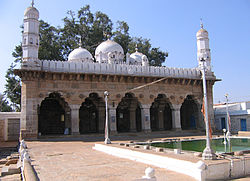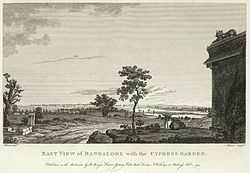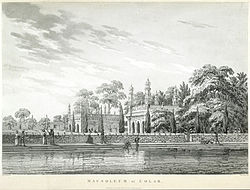
Tipu Sultan, commonly referred to as Sher-e-Mysore or "Tiger of Mysore", was an Indian ruler of the Kingdom of Mysore based in South India. He was a pioneer of rocket artillery. He expanded the iron-cased Mysorean rockets and commissioned the military manual Fathul Mujahidin. He deployed the rockets against advances of British forces and their allies during the Anglo-Mysore Wars, including the Battle of Pollilur and Siege of Srirangapatna.
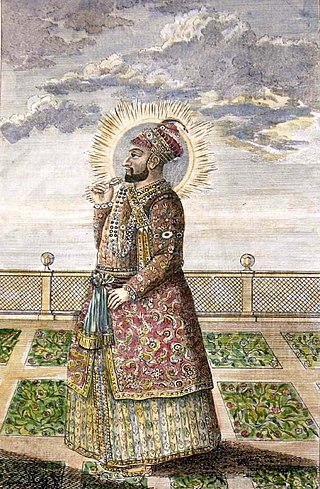
Hyder Ali was the Sultan and de facto ruler of the Kingdom of Mysore in southern India. Born as Hyder Ali, he distinguished himself as a soldier, eventually drawing the attention of Mysore's rulers. Rising to the post of Dalavayi (commander-in-chief) to Krishnaraja Wodeyar II, he came to dominate the titular monarch and the Mysore government. He became the de facto ruler of Mysore as Sarvadhikari by 1761. During intermittent conflicts against the East India Company during the First and Second Anglo–Mysore Wars, Hyder Ali was the military leader.

The Kingdom of Mysore was a geopolitical realm in southern India founded in around 1399 in the vicinity of the modern-day city of Mysore and prevailed until 1950. The territorial boundaries and the form of government transmuted substantially throughout the kingdom's lifetime. While originally a feudal vassal under the Vijayanagara Empire, it became a princely state in British India from 1799 to 1947, marked in-between by major political changes.

The Nawab of Bengal was the hereditary ruler of Bengal Subah in Mughal India. In the early 18th-century, the Nawab of Bengal was the de facto independent ruler of the three regions of Bengal, Bihar and Orissa which constitute the modern-day sovereign country of Bangladesh and the Indian states of West Bengal, Bihar and Odisha. The Bengal Subah reached its peak during the reign of Nawab Shuja-ud-Din Muhammad Khan. They are often referred to as the Nawab of Bengal, Bihar and Orissa. The Nawabs were based in Murshidabad which was centrally located within Bengal, Bihar, and Odisha. Their chief, a former prime minister, became the first Nawab. The Nawabs continued to issue coins in the name of the Mughal Emperor, but for all practical purposes, the Nawabs governed as independent monarchs. Bengal continued to contribute the largest share of funds to the imperial treasury in Delhi. The Nawabs, backed by bankers such as the Jagat Seth, became the financial backbone of the Mughal court.
A Subah was the term for a province (state) in the Mughal Empire. The term was also used by other polities of the Indian subcontinent. The word is derived from Arabic and Persian. The governor/ruler of a Subah was known as a subahdar, which later became subedar to refer to an officer in the Indian Army and Pakistan Army. The subahs were established by badshah (emperor) Akbar during his administrative reforms of the years 1572–1580; initially, they numbered 12, but his conquests expanded the number of subahs to 15 by the end of his reign. Subahs were divided into Sarkars, or districts. Sarkars were further divided into Parganas or Mahals. His successors, most notably Aurangzeb, expanded the number of subahs further through their conquests. As the empire began to dissolve in the early 18th century, many subahs became effectively independent or were conquered by the Marathas or the British.

The Carnatic Sultanate was a kingdom in South India between about 1690 and 1855, and was under the legal purview of the Nizam of Hyderabad, until their demise. They initially had their capital at Arcot in the present-day Indian state of Tamil Nadu. Their rule is an important period in the history of the Carnatic and Coromandel Coast regions, in which the Mughal Empire gave way to the rising influence of the Maratha Empire, and later the emergence of the British Raj.
Sira is a city and taluk headquarters of Sira Taluk of Tumakuru district in the state of Karnataka, India. It lies on the AH 47, NH 48. It is the second largest city in the district after the headquarters by population, area and economy. It is the fastest developing city in the district. The State Capital city, Bengaluru, is 120 km from Sira. It is known for its historical significance as a political and military center and for being the capital of Imperial Sira Subah in the early 1700s.
Sira is a taluk of Tumkur district in the state of Karnataka, India. Its headquarters, Sira city lies on the NH 48 .It is the largest taluk in district by area.Second largest in population and economy.It is most developed regions in district after headquarters.

Lewin Bentham Bowring (1824–1910) was a British Indian civil servant in British India who served as the Chief Commissioner of Mysore between 1862 and 1870. He was also an author and man of letters.
Kanthirava Narasaraja II was the fifteenth maharaja of the Kingdom of Mysore from 1704 to 1714. He was born deaf and came to be called Múk-arasu. He succeeded to the throne through the influence of the prime minister, Tirumala Iyengar. During his reign, his dalvoy, who was also named Kanthirava, led an expedition to subdue Chikkaballapur, but was killed during the fighting. His son later took over and succeeded in establishing Mysore's suzerainty.

Madhavrao II was the 12th Peshwa of the Maratha Confederacy, from his infancy. He was known as Sawai Madhav Rao or Madhav Rao Narayan. He was the posthumous son of Narayanrao Peshwa, murdered in 1773 on the orders of Raghunathrao. Madhavrao II was considered the legal heir, and was installed as Peshwa by the Treaty of Salbai in 1782 after First Anglo-Maratha War.

The political history of the region on the Deccan Plateau in west-central peninsular India that was later divided into Mysore state and Coorg province saw many changes after the fall of the Hindu Vijayanagara Empire in 1565. The rise of Sultan Haidar Ali in 1761 introduced a new period.

The political history of Mysore and Coorg (1761–1799) is the political history of the contiguous historical regions of Mysore State and Coorg province on the Deccan Plateau in west-central peninsular India from the time of the rise of Haidar Ali in 1761 to that of the death of his son Tipu Sultan in 1799.
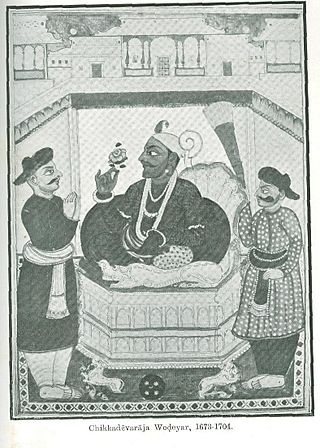
Devaraja Wodeyar II was the fourteenth maharaja of the Kingdom of Mysore from 1673 to 1704. During this time, Mysore saw further significant expansion after his predecessors. During his rule, centralised military power increased to an unprecedented degree for the region.
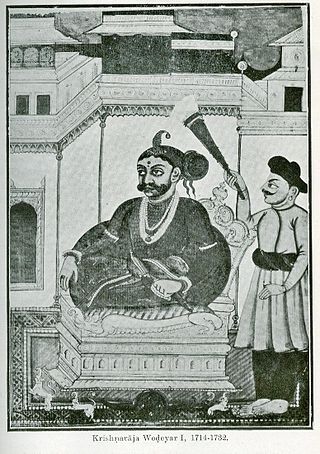
Krishnaraja Wodeyar I was the sixteenth maharaja of the Kingdom of Mysore. His reign lasted for 18 years, from 1714 to 1732.
The captivity of Kodavas (Coorgis) at Seringapatam was the period of capture, deportation, and imprisonment of Kodava Takk speaking Coorgi Christians who rebelled against Tippu Sultan, the de facto ruler of the Kingdom of Mysore, they (60,000-70,000) were caught during a number of attempts to suppress their rebellion in the 1780s.
The Maratha–Mysore wars were a conflict in the 18th century India between the Maratha Confederacy and the Kingdom of Mysore. Though initial hostilities between the sides started in 1760s, the last battle began in February 1785 and ended in 1787.

Fateh Muhammad or Nadim Sahib was a General of the Moghul Empire in Mysore region, and he was the father of Mysore Sultanate founder Hyder Ali, who was his fifth child from his third wife, and the Paternal-Grandfather of the Mysore Sultanate Ruler Tipu Sultan.
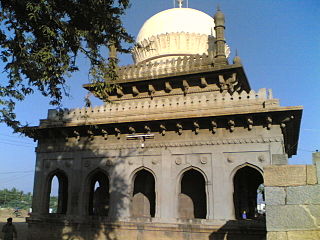
Malik Rihan Dargah, also known as Malik Rihan tomb, is a mausoleum in Sira, Karnataka, India. It contains the grave of Malik Rihan who was the governor of Sira province in the 17th-century. It has a square plan and illustrates the Indo-Saracenic style in Deccan architecture.
Dodda Vira Rajendra was the ruler of the Kingdom of Coorg from 1780 to 1809. He is considered a hero of Coorg history for having freed the kingdom from the occupation of Tipu Sultan, the king of Mysore. He later aided the British in their fight against Tipu Sultan.


